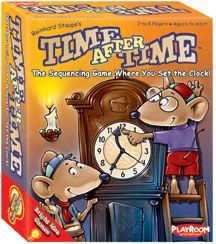Time After Time (2008) Board Game
Time After Time is a card game designed by Reinhard Staupe and published by AMIGO in in 2008. It is a children’s game that is suitable for players aged 6 and above. The game has a runtime of about 10 minutes and can be played by 2 to 4 players.
Game Components of Time After Time
How To Setup Time After Time
To set up the game, each player starts with a row of empty time slots on their board, ranging from 5:00 AM to 11:00 PM. Players draw a handful of time cards from the deck. The objective is to fill in all the time slots in chronological order.
Gameplay Mechanics and Game Objective
Player Experience
Time After Time is an educational yet fun game that teaches children about telling time and logical thinking. Players must strategically place their cards to ensure they have space for future draws. The game is suitable for children, especially those slightly older, as it helps them understand the difference between AM and PM and how to sequence times correctly. Games typically last 15 to 20 minutes.
Pros
Cons
Personal Thoughts on Time After Time
Time After Time is ideal for families or educational settings where teaching time-telling skills is a priority. It is a great introduction to card games and strategic thinking for children. While it may involve some luck, the game’s educational high points and fun factor make it a valuable addition to any family game collection. However, it may not be as engaging for older players looking for more complex gameplay mechanics.
We are supported by our audience. When you purchase through links on our site, we may earn an affiliate commission, at no extra cost for you. Learn more.

